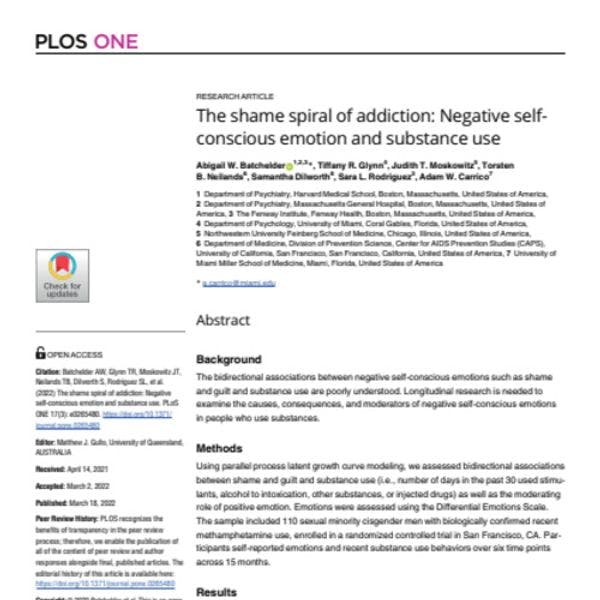El espiral de vergüenza de la adicción: Emoción auto-consciente negativa y consumo de sustancias
Batchelder et al. plantean vínculos entre la vergüenza y culpa internalizadas, y los retos para reducir el consumo de estimulantes. Más información, en inglés, está disponible abajo.
By Abigail W. Batchelder,Tiffany R. Glynn, Judith T. Moskowitz, Torsten B. Neilands, Samantha Dilworth, Sara L. Rodriguez, Adam W. Carrico / PLOS ONE
Abstract
Background
The bidirectional associations between negative self-conscious emotions such as shame and guilt and substance use are poorly understood. Longitudinal research is needed to examine the causes, consequences, and moderators of negative self-conscious emotions in people who use substances.
Methods
Using parallel process latent growth curve modeling, we assessed bidirectional associations between shame and guilt and substance use (i.e., number of days in the past 30 used stimulants, alcohol to intoxication, other substances, or injected drugs) as well as the moderating role of positive emotion. Emotions were assessed using the Differential Emotions Scale. The sample included 110 sexual minority cisgender men with biologically confirmed recent methamphetamine use, enrolled in a randomized controlled trial in San Francisco, CA. Participants self-reported emotions and recent substance use behaviors over six time points across 15 months.
Results
Higher initial levels of shame were associated with slower decreases in stimulant use over time (b = 0.23, p = .041) and guilt was positively associated with stimulant use over time (β = 0.85, p < .0001). Initial levels of guilt and alcohol use were positively related (b = 0.29, p = .040), but over time, they had a negative relationship (β = -0.99, p < .0001). Additionally, higher initial levels of other drug use were associated with slower decreases in shame over time (b = 0.02, p = .041). All results were independent of depression, highlighting the specific role of self-conscious emotions.
Conclusions
Shame and guilt are barriers to reducing stimulant use, and expanded efforts are needed to mitigate the deleterious effects of these self-conscious emotions in recovery from a stimulant use disorder.
